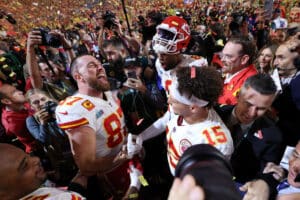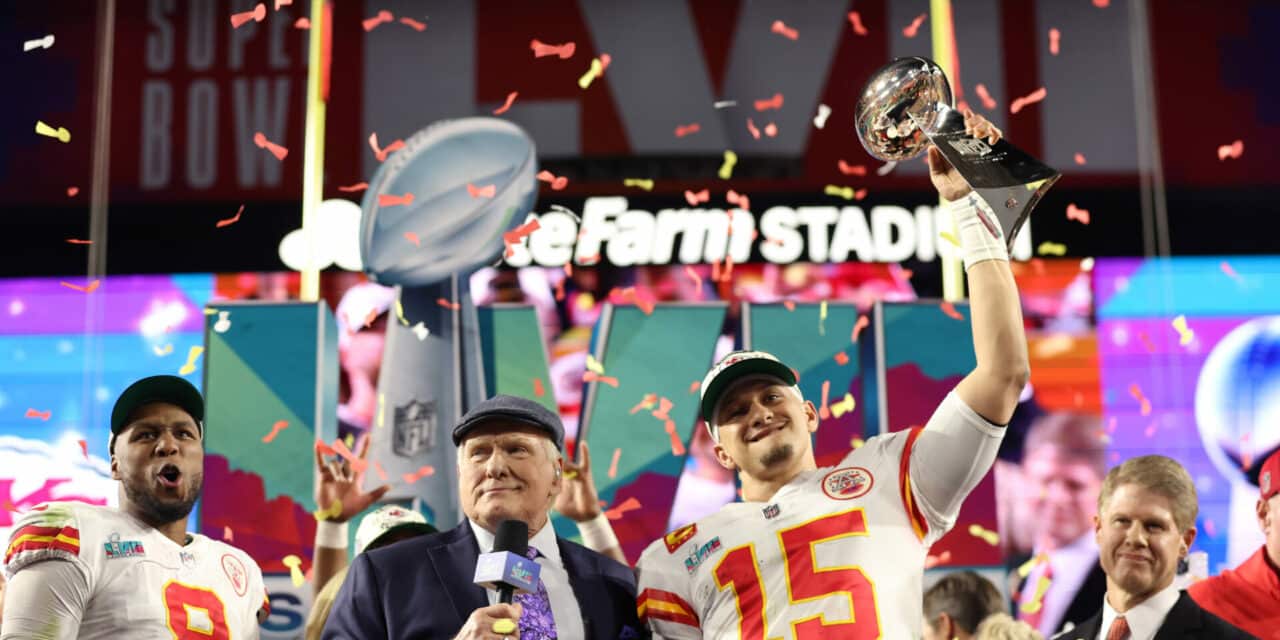MAHOMES IS THE MAN: Kansas City quarterback Patrick Mahomes holds up the Vince Lombardi Trophy after the Chiefs beat the Philadelphia Eagles in Super Bowl LVII. (Getty Images)
Plug pulled by mistake, cutting NFL postgame communications
HOLLYWOOD, California — The Super Bowl is all about key moments in the game that determine the outcome. For Peter O’Reilly, point man for the league’s special events, the Super Bowl LVII postgame celebration on Feb. 12 provided a memorable moment for all the wrong reasons.
During his annual Super Bowl recap via video conference at the Stadium Managers Association seminar, O’Reilly, the NFL’s executive vice president of club business and league events, said NFL Control, the league’s massive “apartment complex” set up for for all things Super Bowl in the north end zone, temporarily lost all communications just prior to the start of the postgame ceremony.
“We had no ability to communicate with anybody down on the field,” O’Reilly told attendees during his Feb. 16 address. “Fortunately, we have great experience and muscle memory there, but we were talking to ourselves at NFL Control for a few minutes. It was just a little thing where a plug was pulled accidentally. We will avoid that (occurrence) in the future.”
Jim Folk, vice president of ballpark operations for the Cleveland Guardians and SMA seminar vice chair, told O’Reilly that the Super Bowl incident reminded him of the scene in Airplane, the 1980 motion picture spoof of the Airport disaster movies, where an air traffic controller playfully pulls the plug on the runway lights before plugging it back in the wall.
“That’s the exact example we were discussing at NFL Control,” O’Reilly said, chuckling. “Airplane was the first reference.”
Another thing on O’Reilly’s to-do list for Super Bowl LVIII is to have kickoff take place on time. In Glendale, Arizona, the kick came four minutes later than 4:40 p.m. Mountain Time as originally scheduled, which is not ideal, considering everything that goes into the game production and sponsors that pay millions of dollars for commercials.
“We got past the point of no return,” he said. “We ended up with an incredible rating and a great game, but those are things on my list that can’t happen. We’ve got to nail it.”

NO CONTROL: Kansas City Chiefs tight end Travis Kelce, left, celebrates with quarterback Patrick Mahomes during the Super Bowl postgame ceremony. NFL Control temporarily lost communications to the field just prior to those activities. (Getty Images)
Otherwise, there weren’t too many stressful situations to deal with on Super Bowl Sunday, except for some hot-air balloons flying over State Farm Stadium the morning of the game. It took place outside of the temporary flight restriction window, O’Reilly said. Ordinarily, it may not have caused too much concern for NFL officials and the law enforcement agencies they work with on security efforts, but after the China balloon incident, there’s been increased vigilance for all things hovering in airspace.
“It was a first for me,” said O’Reilly, completing his eighth Super Bowl after taking over for the retiring Frank Supovitz in 2015. “We always have planes with banners flying around, but this was a couple of hot-air balloons right over the mouth of the roof. In some ways, it was beautiful … but we saw that play out. That was the most visible thing (in terms of potentially breaching air space) and we’ll take that.”
O’Reilly will also take the fact that 30,000 fans cleared security and had their tickets scanned 4.5 hours before kickoff, which helped the NFL immensely in terms of getting people inside the stadium in a timely manner. Most people were in their seats by the time country superstar Chris Stapleton performed the national anthem, according to O’Reilly.
“It was the most full a Super Bowl has ever been for that key 40-minute window when we really start the show and the start of the game and that really builds up in a powerful way,” he said. “It was safe, which is critical and smooth for everything we had going on there.”
Unlike Super Bowls of past years, there were no incidents tied to knucklehead fans attempting to enter the field of play from the stands.
“It was a really good year in that regard,” O’Reilly said. “There was not one field incursion during the game. We had strong mitigation measures in place for any type of incursions, even on the perimeter overall. We were very keen on drones with good conversations across jurisdictions. We may never eliminate those desires, but we can deter, and have great methods in place to sniff that out.”
O’Reilly spoke to the field conditions at State Farm Stadium, which saw several players slip and fall during the game, an issue discussed by Fox announcers Kevin Burkhardt and Greg Olsen during the broadcast. Ironically, over the past 12 years, the stadium’s natural grass surface, which rolls in and out of the stadium on a tray system, has been voted by NFL players on multiple occasions as the best field in the league, according to an annual survey.
“We obviously put a new surface in for Super Bowl and our football folks were happy with it,” O’Reilly said. “It passed all tests independently from the (players association) in terms of the ratings leading into the game. Certainly, there were some slips. If you parse through the players’ comments postgame, there was an understanding of that.”
“We do recognize that there are more stresses on that field than a normal game,” he said. “Inevitably, we had rehearsal of the halftime show on there to make sure we can operationalize a big halftime, so some of those things have an impact, but there’s nothing more important than the field and the game itself.”
Next year’s Super Bowl will be held at Allegiant Stadium in Las Vegas, which has a similar sliding grass tray system modeled after State Farm Stadium.
“We’ll continue to evaluate that and make sure that we have the best possible surface out there for every single game we play,” O’Reilly said. “We feel confident in the surface this game was played on.”







